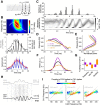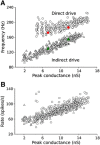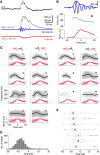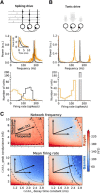Hippocampal Ripple Oscillations and Inhibition-First Network Models: Frequency Dynamics and Response to GABA Modulators
- PMID: 29453207
- PMCID: PMC6596071
- DOI: 10.1523/JNEUROSCI.0188-17.2018
Hippocampal Ripple Oscillations and Inhibition-First Network Models: Frequency Dynamics and Response to GABA Modulators
Abstract
Hippocampal ripples are involved in memory consolidation, but the mechanisms underlying their generation remain unclear. Models relying on interneuron networks in the CA1 region disagree on the predominant source of excitation to interneurons: either "direct," via the Schaffer collaterals that provide feedforward input from CA3 to CA1, or "indirect," via the local pyramidal cells in CA1, which are embedded in a recurrent excitatory-inhibitory network. Here, we used physiologically constrained computational models of basket-cell networks to investigate how they respond to different conditions of transient, noisy excitation. We found that direct excitation of interneurons could evoke ripples (140-220 Hz) that exhibited intraripple frequency accommodation and were frequency-insensitive to GABA modulators, as previously shown in in vitro experiments. In addition, the indirect excitation of the basket-cell network enabled the expression of intraripple frequency accommodation in the fast-gamma range (90-140 Hz), as in vivo In our model, intraripple frequency accommodation results from a hysteresis phenomenon in which the frequency responds differentially to the rising and descending phases of the transient excitation. Such a phenomenon predicts a maximum oscillation frequency occurring several milliseconds before the peak of excitation. We confirmed this prediction for ripples in brain slices from male mice. These results suggest that ripple and fast-gamma episodes are produced by the same interneuron network that is recruited via different excitatory input pathways, which could be supported by the previously reported intralaminar connectivity bias between basket cells and functionally distinct subpopulations of pyramidal cells in CA1. Together, our findings unify competing inhibition-first models of rhythm generation in the hippocampus.SIGNIFICANCE STATEMENT The hippocampus is a part of the brain of humans and other mammals that is critical for the acquisition and consolidation of memories. During deep sleep and resting periods, the hippocampus generates high-frequency (∼200 Hz) oscillations called ripples, which are important for memory consolidation. The mechanisms underlying ripple generation are not well understood. A prominent hypothesis holds that the ripples are generated by local recurrent networks of inhibitory neurons. Using computational models and experiments in brain slices from rodents, we show that the dynamics of interneuron networks clarify several previously unexplained characteristics of ripple oscillations, which advances our understanding of hippocampus-dependent memory consolidation.
Keywords: CA1; basket cells; fast gamma; memory consolidation; network oscillations; sharp wave/ripple complexes.
Copyright © 2018 the authors 0270-6474/18/383125-23$15.00/0.
Figures









Comment in
-
Feedback and Feedforward Inhibition May Resonate Distinctly in the Ripple Symphony.J Neurosci. 2018 Jul 25;38(30):6612-6614. doi: 10.1523/JNEUROSCI.1054-18.2018. J Neurosci. 2018. PMID: 30045968 Free PMC article. No abstract available.
Similar articles
-
Interneuronal gap junctions increase synchrony and robustness of hippocampal ripple oscillations.Eur J Neurosci. 2018 Dec;48(12):3446-3465. doi: 10.1111/ejn.14267. Eur J Neurosci. 2018. PMID: 30414336
-
Hippocampal CA1 Ripples as Inhibitory Transients.PLoS Comput Biol. 2016 Apr 19;12(4):e1004880. doi: 10.1371/journal.pcbi.1004880. eCollection 2016 Apr. PLoS Comput Biol. 2016. PMID: 27093059 Free PMC article.
-
High-frequency oscillations and sequence generation in two-population models of hippocampal region CA1.PLoS Comput Biol. 2022 Feb 17;18(2):e1009891. doi: 10.1371/journal.pcbi.1009891. eCollection 2022 Feb. PLoS Comput Biol. 2022. PMID: 35176028 Free PMC article.
-
[Hippocampal ripple oscillations (200 Hz) in mechanisms of memory consolidation].Usp Fiziol Nauk. 2002 Oct-Dec;33(4):34-42. Usp Fiziol Nauk. 2002. PMID: 12449805 Review. Russian.
-
[Neural mechanism underlying generation of synchronous oscillations in hippocampal network].Brain Nerve. 2008 Jul;60(7):755-62. Brain Nerve. 2008. PMID: 18646615 Review. Japanese.
Cited by
-
Neuregulin 1 and ErbB4 Kinase Actively Regulate Sharp Wave Ripples in the Hippocampus.J Neurosci. 2022 Jan 19;42(3):390-404. doi: 10.1523/JNEUROSCI.1022-21.2021. Epub 2021 Nov 29. J Neurosci. 2022. PMID: 34844988 Free PMC article.
-
Mechanisms of neural organization and rhythmogenesis during hippocampal and cortical ripples.Philos Trans R Soc Lond B Biol Sci. 2020 May 25;375(1799):20190237. doi: 10.1098/rstb.2019.0237. Epub 2020 Apr 6. Philos Trans R Soc Lond B Biol Sci. 2020. PMID: 32248777 Free PMC article. Review.
-
Regulating synchronous oscillations of cerebellar granule cells by different types of inhibition.PLoS Comput Biol. 2021 Jun 28;17(6):e1009163. doi: 10.1371/journal.pcbi.1009163. eCollection 2021 Jun. PLoS Comput Biol. 2021. PMID: 34181653 Free PMC article.
-
Gating of hippocampal rhythms and memory by synaptic plasticity in inhibitory interneurons.Neuron. 2021 Mar 17;109(6):1013-1028.e9. doi: 10.1016/j.neuron.2021.01.014. Epub 2021 Feb 5. Neuron. 2021. PMID: 33548174 Free PMC article.
-
Mapping input noise to escape noise in integrate-and-fire neurons: a level-crossing approach.Biol Cybern. 2021 Oct;115(5):539-562. doi: 10.1007/s00422-021-00899-1. Epub 2021 Oct 19. Biol Cybern. 2021. PMID: 34668051 Free PMC article.
References
-
- Aika Y, Ren JQ, Kosaka K, Kosaka T (1994) Quantitative analysis of GABA-like-immunoreactive and parvalbumin-containing neurons in the CA1 region of the rat hippocampus using a stereological method, the disector. Exp Brain Res 99:267–276. - PubMed
Publication types
MeSH terms
Substances
LinkOut - more resources
Full Text Sources
Other Literature Sources
Miscellaneous
